Does Chlorhexidine Dressing Prevent CVC Line Infections? A Report
VerifiedAdded on 2019/10/30
|7
|1518
|167
Report
AI Summary
This report investigates the efficacy of chlorhexidine dressings in preventing Central Venous Catheter (CVC) line infections in critically ill patients. The study focuses on a focused question, exploring whether chlorhexidine dressings reduce CVC line infections compared to alternative methods like povidone-iodine. The report includes an evidence table summarizing key research studies, their methodologies, and findings. It highlights the population, intervention, comparison, and outcome (PICO) framework, and provides a theoretical framework discussing the susceptibility of critically ill patients to CVC-related infections. The report emphasizes the importance of sterile procedures and the potential of chlorhexidine dressings in reducing infection rates. A change model, based on Kurt Lewin's three-step approach (unfreezing, moving, and refreezing), is proposed to integrate the use of chlorhexidine dressings into clinical practice. The report concludes by emphasizing the importance of healthcare worker education and informed choices to prevent and reduce CVC line infections, supported by various cited research studies.
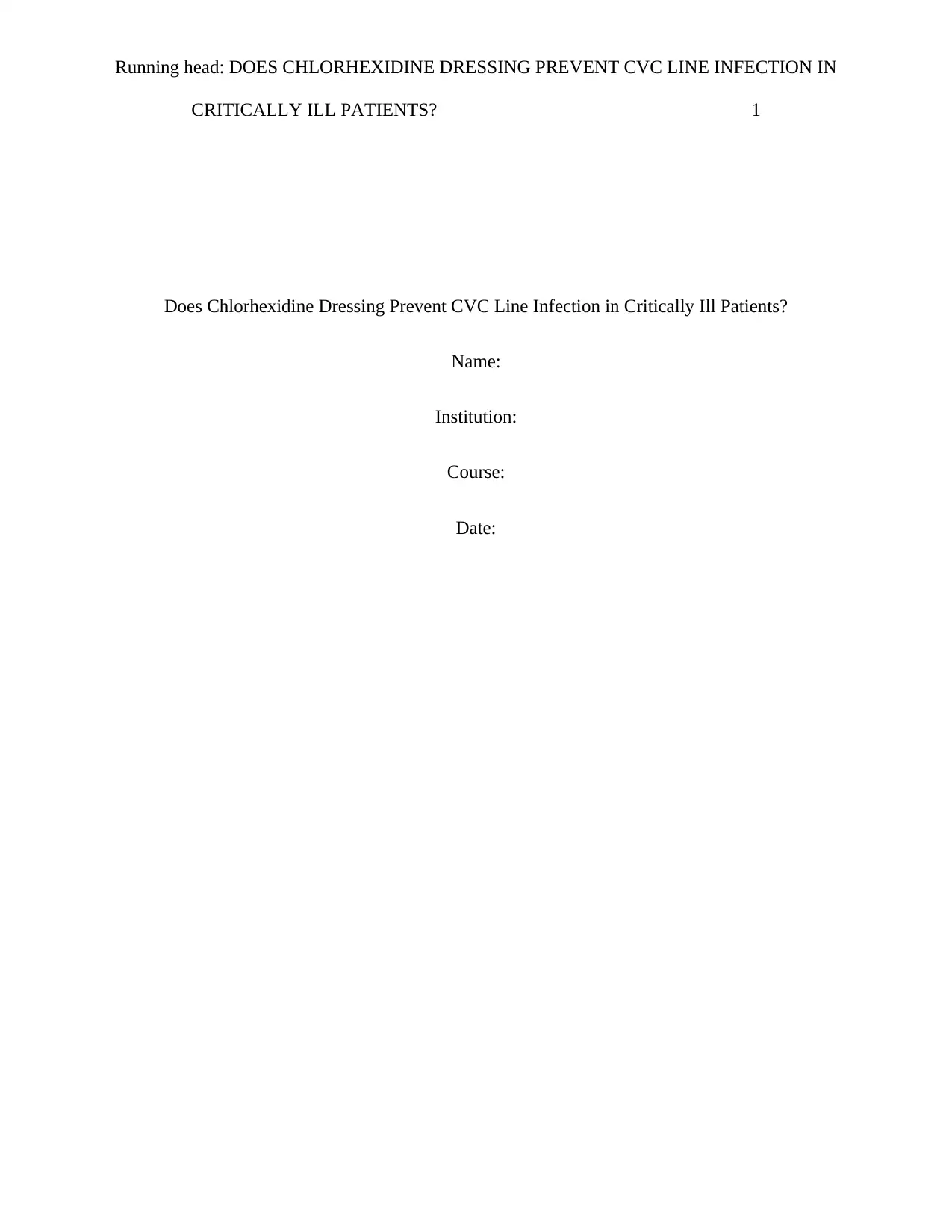
Running head: DOES CHLORHEXIDINE DRESSING PREVENT CVC LINE INFECTION IN
CRITICALLY ILL PATIENTS? 1
Does Chlorhexidine Dressing Prevent CVC Line Infection in Critically Ill Patients?
Name:
Institution:
Course:
Date:
CRITICALLY ILL PATIENTS? 1
Does Chlorhexidine Dressing Prevent CVC Line Infection in Critically Ill Patients?
Name:
Institution:
Course:
Date:
Paraphrase This Document
Need a fresh take? Get an instant paraphrase of this document with our AI Paraphraser
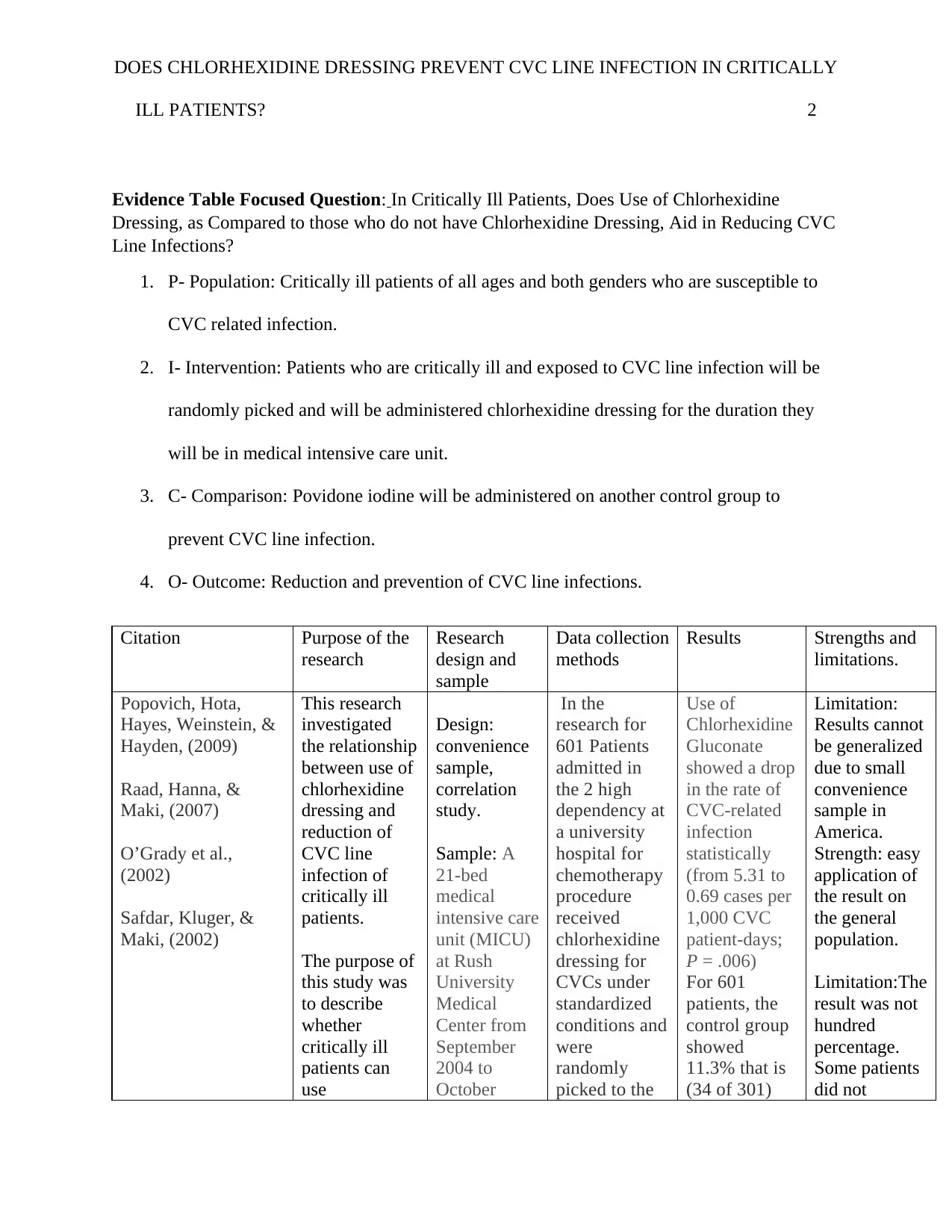
DOES CHLORHEXIDINE DRESSING PREVENT CVC LINE INFECTION IN CRITICALLY
ILL PATIENTS? 2
Evidence Table Focused Question: In Critically Ill Patients, Does Use of Chlorhexidine
Dressing, as Compared to those who do not have Chlorhexidine Dressing, Aid in Reducing CVC
Line Infections?
1. P- Population: Critically ill patients of all ages and both genders who are susceptible to
CVC related infection.
2. I- Intervention: Patients who are critically ill and exposed to CVC line infection will be
randomly picked and will be administered chlorhexidine dressing for the duration they
will be in medical intensive care unit.
3. C- Comparison: Povidone iodine will be administered on another control group to
prevent CVC line infection.
4. O- Outcome: Reduction and prevention of CVC line infections.
Citation Purpose of the
research
Research
design and
sample
Data collection
methods
Results Strengths and
limitations.
Popovich, Hota,
Hayes, Weinstein, &
Hayden, (2009)
Raad, Hanna, &
Maki, (2007)
O’Grady et al.,
(2002)
Safdar, Kluger, &
Maki, (2002)
This research
investigated
the relationship
between use of
chlorhexidine
dressing and
reduction of
CVC line
infection of
critically ill
patients.
The purpose of
this study was
to describe
whether
critically ill
patients can
use
Design:
convenience
sample,
correlation
study.
Sample: A
21-bed
medical
intensive care
unit (MICU)
at Rush
University
Medical
Center from
September
2004 to
October
In the
research for
601 Patients
admitted in
the 2 high
dependency at
a university
hospital for
chemotherapy
procedure
received
chlorhexidine
dressing for
CVCs under
standardized
conditions and
were
randomly
picked to the
Use of
Chlorhexidine
Gluconate
showed a drop
in the rate of
CVC-related
infection
statistically
(from 5.31 to
0.69 cases per
1,000 CVC
patient-days;
P = .006)
For 601
patients, the
control group
showed
11.3% that is
(34 of 301)
Limitation:
Results cannot
be generalized
due to small
convenience
sample in
America.
Strength: easy
application of
the result on
the general
population.
Limitation:The
result was not
hundred
percentage.
Some patients
did not
ILL PATIENTS? 2
Evidence Table Focused Question: In Critically Ill Patients, Does Use of Chlorhexidine
Dressing, as Compared to those who do not have Chlorhexidine Dressing, Aid in Reducing CVC
Line Infections?
1. P- Population: Critically ill patients of all ages and both genders who are susceptible to
CVC related infection.
2. I- Intervention: Patients who are critically ill and exposed to CVC line infection will be
randomly picked and will be administered chlorhexidine dressing for the duration they
will be in medical intensive care unit.
3. C- Comparison: Povidone iodine will be administered on another control group to
prevent CVC line infection.
4. O- Outcome: Reduction and prevention of CVC line infections.
Citation Purpose of the
research
Research
design and
sample
Data collection
methods
Results Strengths and
limitations.
Popovich, Hota,
Hayes, Weinstein, &
Hayden, (2009)
Raad, Hanna, &
Maki, (2007)
O’Grady et al.,
(2002)
Safdar, Kluger, &
Maki, (2002)
This research
investigated
the relationship
between use of
chlorhexidine
dressing and
reduction of
CVC line
infection of
critically ill
patients.
The purpose of
this study was
to describe
whether
critically ill
patients can
use
Design:
convenience
sample,
correlation
study.
Sample: A
21-bed
medical
intensive care
unit (MICU)
at Rush
University
Medical
Center from
September
2004 to
October
In the
research for
601 Patients
admitted in
the 2 high
dependency at
a university
hospital for
chemotherapy
procedure
received
chlorhexidine
dressing for
CVCs under
standardized
conditions and
were
randomly
picked to the
Use of
Chlorhexidine
Gluconate
showed a drop
in the rate of
CVC-related
infection
statistically
(from 5.31 to
0.69 cases per
1,000 CVC
patient-days;
P = .006)
For 601
patients, the
control group
showed
11.3% that is
(34 of 301)
Limitation:
Results cannot
be generalized
due to small
convenience
sample in
America.
Strength: easy
application of
the result on
the general
population.
Limitation:The
result was not
hundred
percentage.
Some patients
did not
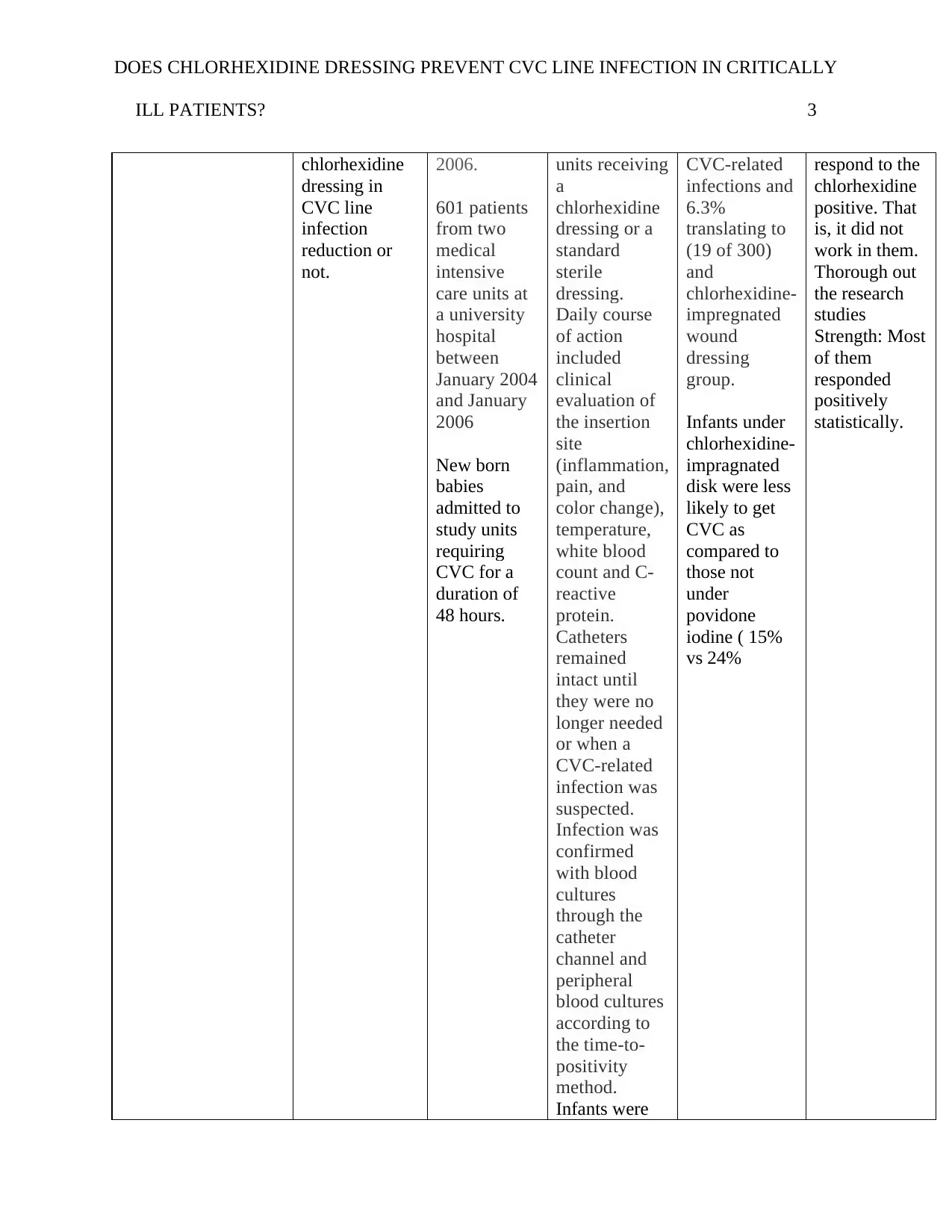
DOES CHLORHEXIDINE DRESSING PREVENT CVC LINE INFECTION IN CRITICALLY
ILL PATIENTS? 3
chlorhexidine
dressing in
CVC line
infection
reduction or
not.
2006.
601 patients
from two
medical
intensive
care units at
a university
hospital
between
January 2004
and January
2006
New born
babies
admitted to
study units
requiring
CVC for a
duration of
48 hours.
units receiving
a
chlorhexidine
dressing or a
standard
sterile
dressing.
Daily course
of action
included
clinical
evaluation of
the insertion
site
(inflammation,
pain, and
color change),
temperature,
white blood
count and C-
reactive
protein.
Catheters
remained
intact until
they were no
longer needed
or when a
CVC-related
infection was
suspected.
Infection was
confirmed
with blood
cultures
through the
catheter
channel and
peripheral
blood cultures
according to
the time-to-
positivity
method.
Infants were
CVC-related
infections and
6.3%
translating to
(19 of 300)
and
chlorhexidine-
impregnated
wound
dressing
group.
Infants under
chlorhexidine-
impragnated
disk were less
likely to get
CVC as
compared to
those not
under
povidone
iodine ( 15%
vs 24%
respond to the
chlorhexidine
positive. That
is, it did not
work in them.
Thorough out
the research
studies
Strength: Most
of them
responded
positively
statistically.
ILL PATIENTS? 3
chlorhexidine
dressing in
CVC line
infection
reduction or
not.
2006.
601 patients
from two
medical
intensive
care units at
a university
hospital
between
January 2004
and January
2006
New born
babies
admitted to
study units
requiring
CVC for a
duration of
48 hours.
units receiving
a
chlorhexidine
dressing or a
standard
sterile
dressing.
Daily course
of action
included
clinical
evaluation of
the insertion
site
(inflammation,
pain, and
color change),
temperature,
white blood
count and C-
reactive
protein.
Catheters
remained
intact until
they were no
longer needed
or when a
CVC-related
infection was
suspected.
Infection was
confirmed
with blood
cultures
through the
catheter
channel and
peripheral
blood cultures
according to
the time-to-
positivity
method.
Infants were
CVC-related
infections and
6.3%
translating to
(19 of 300)
and
chlorhexidine-
impregnated
wound
dressing
group.
Infants under
chlorhexidine-
impragnated
disk were less
likely to get
CVC as
compared to
those not
under
povidone
iodine ( 15%
vs 24%
respond to the
chlorhexidine
positive. That
is, it did not
work in them.
Thorough out
the research
studies
Strength: Most
of them
responded
positively
statistically.
⊘ This is a preview!⊘
Do you want full access?
Subscribe today to unlock all pages.

Trusted by 1+ million students worldwide
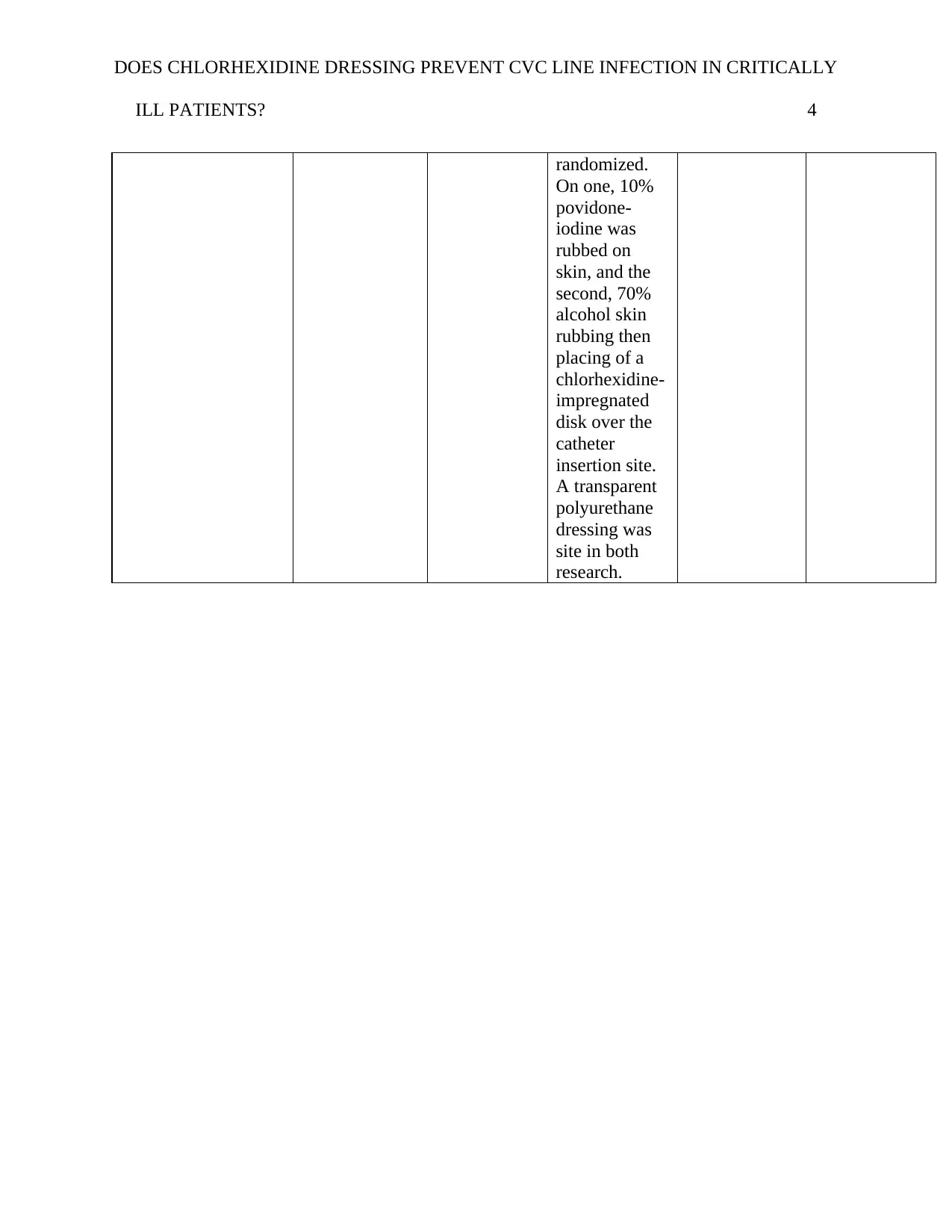
DOES CHLORHEXIDINE DRESSING PREVENT CVC LINE INFECTION IN CRITICALLY
ILL PATIENTS? 4
randomized.
On one, 10%
povidone-
iodine was
rubbed on
skin, and the
second, 70%
alcohol skin
rubbing then
placing of a
chlorhexidine-
impregnated
disk over the
catheter
insertion site.
A transparent
polyurethane
dressing was
site in both
research.
ILL PATIENTS? 4
randomized.
On one, 10%
povidone-
iodine was
rubbed on
skin, and the
second, 70%
alcohol skin
rubbing then
placing of a
chlorhexidine-
impregnated
disk over the
catheter
insertion site.
A transparent
polyurethane
dressing was
site in both
research.
Paraphrase This Document
Need a fresh take? Get an instant paraphrase of this document with our AI Paraphraser
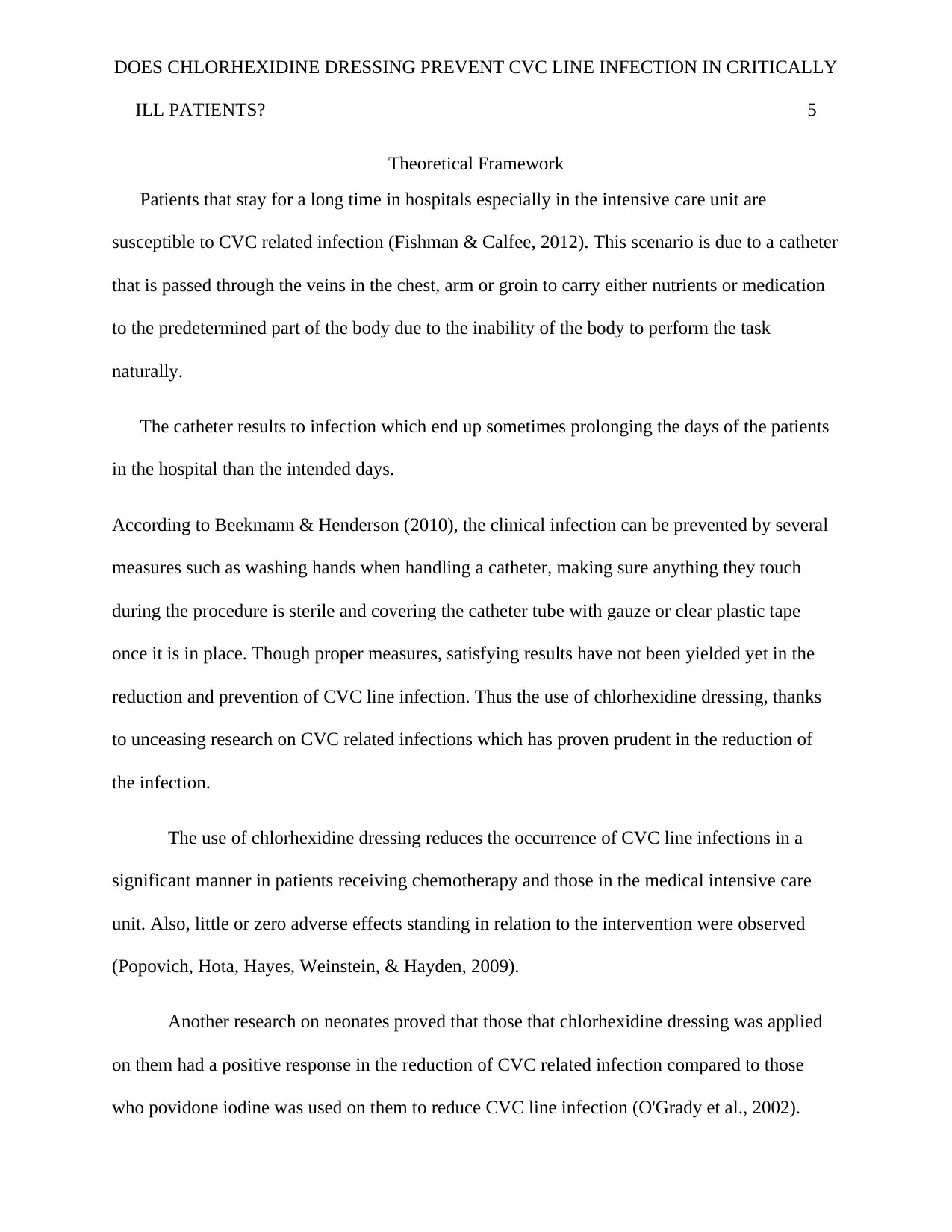
DOES CHLORHEXIDINE DRESSING PREVENT CVC LINE INFECTION IN CRITICALLY
ILL PATIENTS? 5
Theoretical Framework
Patients that stay for a long time in hospitals especially in the intensive care unit are
susceptible to CVC related infection (Fishman & Calfee, 2012). This scenario is due to a catheter
that is passed through the veins in the chest, arm or groin to carry either nutrients or medication
to the predetermined part of the body due to the inability of the body to perform the task
naturally.
The catheter results to infection which end up sometimes prolonging the days of the patients
in the hospital than the intended days.
According to Beekmann & Henderson (2010), the clinical infection can be prevented by several
measures such as washing hands when handling a catheter, making sure anything they touch
during the procedure is sterile and covering the catheter tube with gauze or clear plastic tape
once it is in place. Though proper measures, satisfying results have not been yielded yet in the
reduction and prevention of CVC line infection. Thus the use of chlorhexidine dressing, thanks
to unceasing research on CVC related infections which has proven prudent in the reduction of
the infection.
The use of chlorhexidine dressing reduces the occurrence of CVC line infections in a
significant manner in patients receiving chemotherapy and those in the medical intensive care
unit. Also, little or zero adverse effects standing in relation to the intervention were observed
(Popovich, Hota, Hayes, Weinstein, & Hayden, 2009).
Another research on neonates proved that those that chlorhexidine dressing was applied
on them had a positive response in the reduction of CVC related infection compared to those
who povidone iodine was used on them to reduce CVC line infection (O'Grady et al., 2002).
ILL PATIENTS? 5
Theoretical Framework
Patients that stay for a long time in hospitals especially in the intensive care unit are
susceptible to CVC related infection (Fishman & Calfee, 2012). This scenario is due to a catheter
that is passed through the veins in the chest, arm or groin to carry either nutrients or medication
to the predetermined part of the body due to the inability of the body to perform the task
naturally.
The catheter results to infection which end up sometimes prolonging the days of the patients
in the hospital than the intended days.
According to Beekmann & Henderson (2010), the clinical infection can be prevented by several
measures such as washing hands when handling a catheter, making sure anything they touch
during the procedure is sterile and covering the catheter tube with gauze or clear plastic tape
once it is in place. Though proper measures, satisfying results have not been yielded yet in the
reduction and prevention of CVC line infection. Thus the use of chlorhexidine dressing, thanks
to unceasing research on CVC related infections which has proven prudent in the reduction of
the infection.
The use of chlorhexidine dressing reduces the occurrence of CVC line infections in a
significant manner in patients receiving chemotherapy and those in the medical intensive care
unit. Also, little or zero adverse effects standing in relation to the intervention were observed
(Popovich, Hota, Hayes, Weinstein, & Hayden, 2009).
Another research on neonates proved that those that chlorhexidine dressing was applied
on them had a positive response in the reduction of CVC related infection compared to those
who povidone iodine was used on them to reduce CVC line infection (O'Grady et al., 2002).
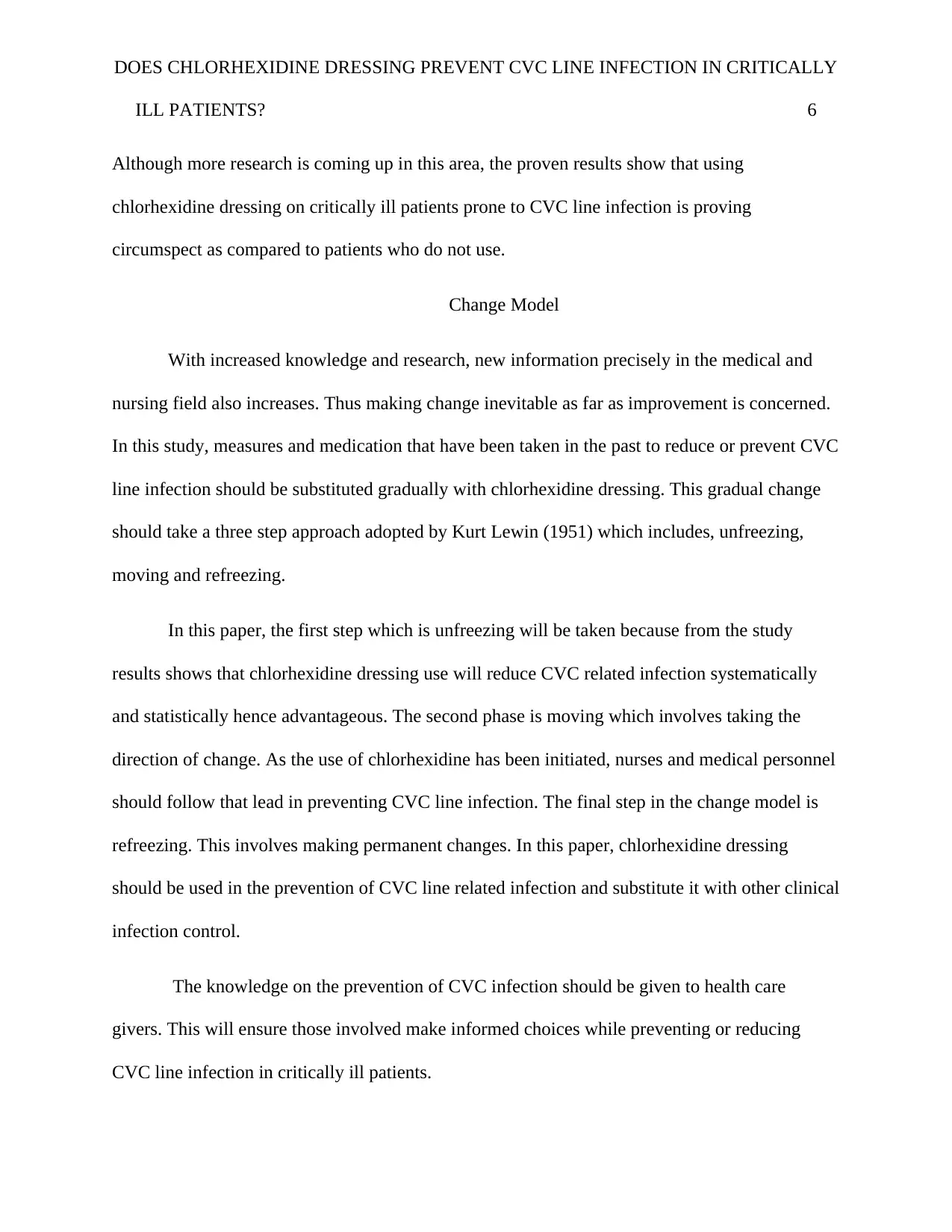
DOES CHLORHEXIDINE DRESSING PREVENT CVC LINE INFECTION IN CRITICALLY
ILL PATIENTS? 6
Although more research is coming up in this area, the proven results show that using
chlorhexidine dressing on critically ill patients prone to CVC line infection is proving
circumspect as compared to patients who do not use.
Change Model
With increased knowledge and research, new information precisely in the medical and
nursing field also increases. Thus making change inevitable as far as improvement is concerned.
In this study, measures and medication that have been taken in the past to reduce or prevent CVC
line infection should be substituted gradually with chlorhexidine dressing. This gradual change
should take a three step approach adopted by Kurt Lewin (1951) which includes, unfreezing,
moving and refreezing.
In this paper, the first step which is unfreezing will be taken because from the study
results shows that chlorhexidine dressing use will reduce CVC related infection systematically
and statistically hence advantageous. The second phase is moving which involves taking the
direction of change. As the use of chlorhexidine has been initiated, nurses and medical personnel
should follow that lead in preventing CVC line infection. The final step in the change model is
refreezing. This involves making permanent changes. In this paper, chlorhexidine dressing
should be used in the prevention of CVC line related infection and substitute it with other clinical
infection control.
The knowledge on the prevention of CVC infection should be given to health care
givers. This will ensure those involved make informed choices while preventing or reducing
CVC line infection in critically ill patients.
ILL PATIENTS? 6
Although more research is coming up in this area, the proven results show that using
chlorhexidine dressing on critically ill patients prone to CVC line infection is proving
circumspect as compared to patients who do not use.
Change Model
With increased knowledge and research, new information precisely in the medical and
nursing field also increases. Thus making change inevitable as far as improvement is concerned.
In this study, measures and medication that have been taken in the past to reduce or prevent CVC
line infection should be substituted gradually with chlorhexidine dressing. This gradual change
should take a three step approach adopted by Kurt Lewin (1951) which includes, unfreezing,
moving and refreezing.
In this paper, the first step which is unfreezing will be taken because from the study
results shows that chlorhexidine dressing use will reduce CVC related infection systematically
and statistically hence advantageous. The second phase is moving which involves taking the
direction of change. As the use of chlorhexidine has been initiated, nurses and medical personnel
should follow that lead in preventing CVC line infection. The final step in the change model is
refreezing. This involves making permanent changes. In this paper, chlorhexidine dressing
should be used in the prevention of CVC line related infection and substitute it with other clinical
infection control.
The knowledge on the prevention of CVC infection should be given to health care
givers. This will ensure those involved make informed choices while preventing or reducing
CVC line infection in critically ill patients.
⊘ This is a preview!⊘
Do you want full access?
Subscribe today to unlock all pages.

Trusted by 1+ million students worldwide
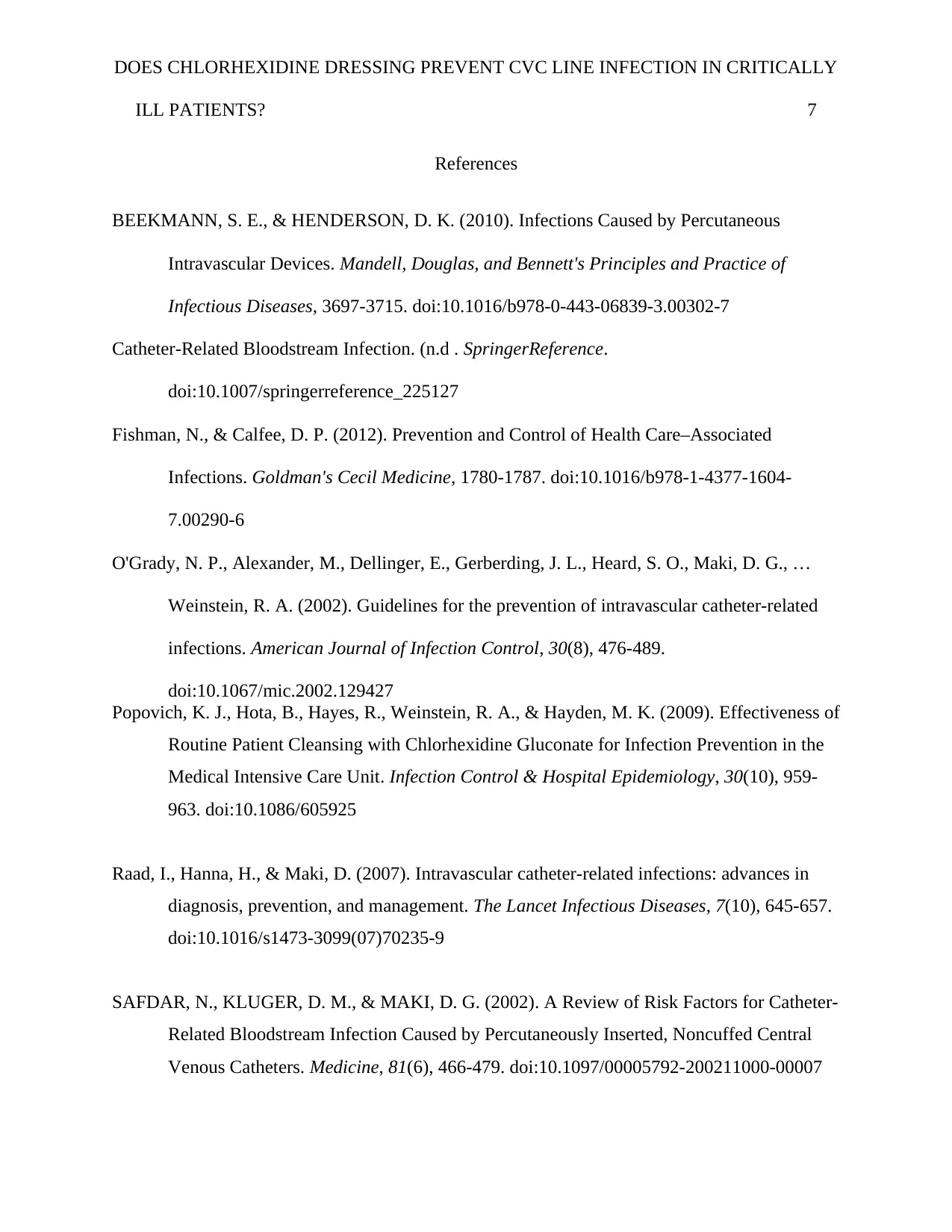
DOES CHLORHEXIDINE DRESSING PREVENT CVC LINE INFECTION IN CRITICALLY
ILL PATIENTS? 7
References
BEEKMANN, S. E., & HENDERSON, D. K. (2010). Infections Caused by Percutaneous
Intravascular Devices. Mandell, Douglas, and Bennett's Principles and Practice of
Infectious Diseases, 3697-3715. doi:10.1016/b978-0-443-06839-3.00302-7
Catheter-Related Bloodstream Infection. (n.d . SpringerReference.
doi:10.1007/springerreference_225127
Fishman, N., & Calfee, D. P. (2012). Prevention and Control of Health Care–Associated
Infections. Goldman's Cecil Medicine, 1780-1787. doi:10.1016/b978-1-4377-1604-
7.00290-6
O'Grady, N. P., Alexander, M., Dellinger, E., Gerberding, J. L., Heard, S. O., Maki, D. G., …
Weinstein, R. A. (2002). Guidelines for the prevention of intravascular catheter-related
infections. American Journal of Infection Control, 30(8), 476-489.
doi:10.1067/mic.2002.129427
Popovich, K. J., Hota, B., Hayes, R., Weinstein, R. A., & Hayden, M. K. (2009). Effectiveness of
Routine Patient Cleansing with Chlorhexidine Gluconate for Infection Prevention in the
Medical Intensive Care Unit. Infection Control & Hospital Epidemiology, 30(10), 959-
963. doi:10.1086/605925
Raad, I., Hanna, H., & Maki, D. (2007). Intravascular catheter-related infections: advances in
diagnosis, prevention, and management. The Lancet Infectious Diseases, 7(10), 645-657.
doi:10.1016/s1473-3099(07)70235-9
SAFDAR, N., KLUGER, D. M., & MAKI, D. G. (2002). A Review of Risk Factors for Catheter-
Related Bloodstream Infection Caused by Percutaneously Inserted, Noncuffed Central
Venous Catheters. Medicine, 81(6), 466-479. doi:10.1097/00005792-200211000-00007
ILL PATIENTS? 7
References
BEEKMANN, S. E., & HENDERSON, D. K. (2010). Infections Caused by Percutaneous
Intravascular Devices. Mandell, Douglas, and Bennett's Principles and Practice of
Infectious Diseases, 3697-3715. doi:10.1016/b978-0-443-06839-3.00302-7
Catheter-Related Bloodstream Infection. (n.d . SpringerReference.
doi:10.1007/springerreference_225127
Fishman, N., & Calfee, D. P. (2012). Prevention and Control of Health Care–Associated
Infections. Goldman's Cecil Medicine, 1780-1787. doi:10.1016/b978-1-4377-1604-
7.00290-6
O'Grady, N. P., Alexander, M., Dellinger, E., Gerberding, J. L., Heard, S. O., Maki, D. G., …
Weinstein, R. A. (2002). Guidelines for the prevention of intravascular catheter-related
infections. American Journal of Infection Control, 30(8), 476-489.
doi:10.1067/mic.2002.129427
Popovich, K. J., Hota, B., Hayes, R., Weinstein, R. A., & Hayden, M. K. (2009). Effectiveness of
Routine Patient Cleansing with Chlorhexidine Gluconate for Infection Prevention in the
Medical Intensive Care Unit. Infection Control & Hospital Epidemiology, 30(10), 959-
963. doi:10.1086/605925
Raad, I., Hanna, H., & Maki, D. (2007). Intravascular catheter-related infections: advances in
diagnosis, prevention, and management. The Lancet Infectious Diseases, 7(10), 645-657.
doi:10.1016/s1473-3099(07)70235-9
SAFDAR, N., KLUGER, D. M., & MAKI, D. G. (2002). A Review of Risk Factors for Catheter-
Related Bloodstream Infection Caused by Percutaneously Inserted, Noncuffed Central
Venous Catheters. Medicine, 81(6), 466-479. doi:10.1097/00005792-200211000-00007
1 out of 7
Related Documents
Your All-in-One AI-Powered Toolkit for Academic Success.
+13062052269
info@desklib.com
Available 24*7 on WhatsApp / Email
![[object Object]](/_next/static/media/star-bottom.7253800d.svg)
Unlock your academic potential
Copyright © 2020–2025 A2Z Services. All Rights Reserved. Developed and managed by ZUCOL.





